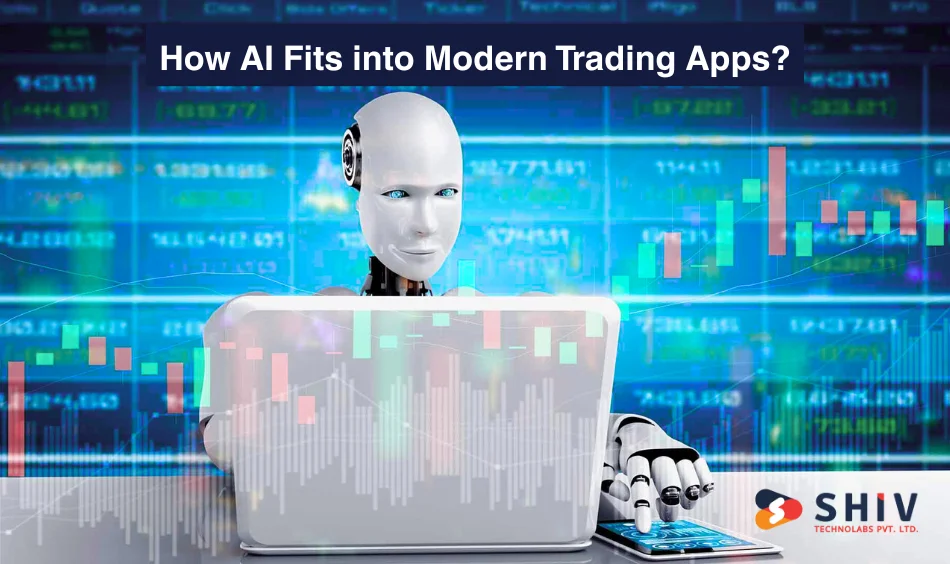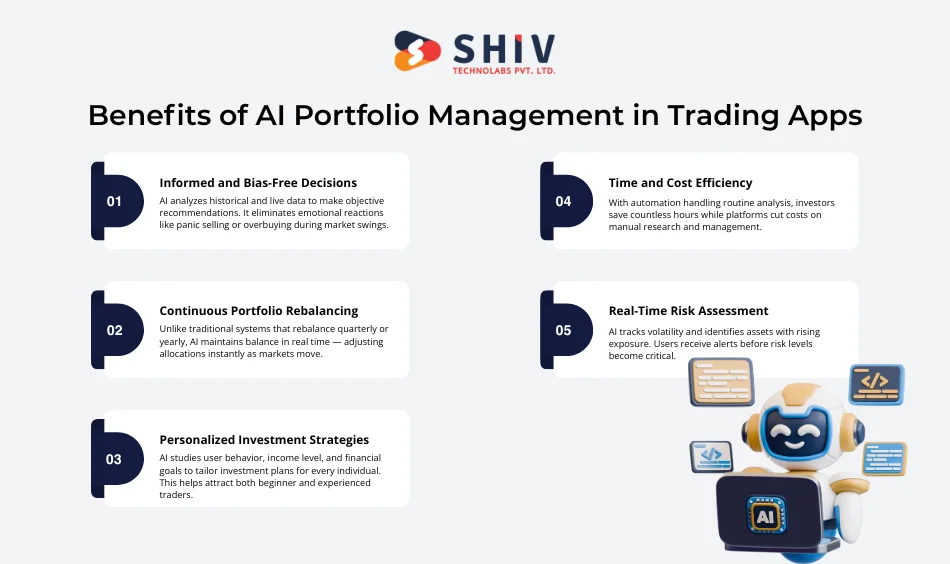Table of Contents
Investors no longer depend only on human judgment or manual analysis to grow their portfolios. With the rise of artificial intelligence, trading apps are shifting toward smarter, data-driven portfolio management. AI brings precision and consistency that human decision-making often lacks.
For developers and fintech companies, adding AI portfolio management means more than just automation — it’s about predicting patterns, analyzing risks, and adapting portfolios to changing market behavior. AI models can analyze millions of data points in seconds, helping users make informed investment decisions without emotional bias.
In this blog, we’ll understand what AI portfolio management means, how it fits into trading apps, and the practical steps to build one with the right technology stack.
What Is AI Portfolio Management?
AI portfolio management refers to using machine learning algorithms and predictive analytics to monitor, allocate, and adjust investment portfolios automatically.
Unlike traditional portfolio management, which depends heavily on manual input and human expertise, AI-driven systems process vast financial data in real time — identifying trends and rebalancing assets with precision.
These systems study historical patterns, current market signals, and user behavior to suggest or even execute trades. Over time, they learn and adapt — improving accuracy and responsiveness to market volatility.
Here’s what sets AI portfolio management apart:
- Real-time analysis: Processes live market and economic data instantly.
- Emotion-free decisions: Remove human biases during market highs and lows.
- Dynamic rebalancing: Adjusts portfolios automatically to maintain optimal risk-return ratios.
- Personalized investment models: Tailor strategies based on each user’s goals, risk tolerance, and time horizon.
In short, AI portfolio management transforms passive trading apps into intelligent financial advisors that think and act on behalf of investors.
How AI Fits into Modern Trading Apps?

AI is no longer an optional feature for trading apps — it’s becoming a core part of how portfolios are managed and decisions are made.
By integrating machine learning, data analytics, and natural language processing, trading platforms can provide investors with smarter insights and better control over their investments.
Here’s how AI strengthens trading apps:
- Predictive Analysis: AI studies historical data to forecast asset performance and detect early trends in stocks, commodities, or crypto.
- Automated Rebalancing: Instead of manual intervention, AI continuously adjusts portfolio allocations to maintain the desired risk-return balance.
- Sentiment Tracking: Natural language models scan financial news, expert opinions, and social media sentiment to predict market reactions.
- Risk Management: AI tools identify volatility patterns, track exposure levels, and send early alerts for potential losses.
- Smart Recommendations: Based on investor behavior, AI can suggest reallocation strategies, emerging assets, or profitable exit points.
These capabilities help transform regular trading apps into proactive investment companions that guide users through every market phase with data-driven accuracy.
Core Features to Add When Building an AI Portfolio Management
To make your trading app truly intelligent, you need to integrate features that combine data science, automation, and user experience. Each feature should deliver clear value — either by improving decision-making, reducing manual effort, or strengthening user trust.
Here are the must-have features to include:
1. AI-Powered Portfolio Insights
Give users a clear view of how their portfolio is performing. Use AI to show diversification scores, sector exposure, and real-time profit or loss predictions. These insights help investors adjust their strategy faster.
2. Smart Rebalancing and Alerts
Allow the app to monitor portfolio composition and automatically rebalance assets when certain thresholds are crossed. Add smart alerts for sudden changes, performance dips, or news affecting owned stocks.
3. Predictive Asset Allocation
Machine learning models can study thousands of data points — interest rates, market cycles, and user preferences — to suggest the ideal asset mix for each investor.
4. AI Chat Assistant for Investors
Integrate an AI assistant that can answer real-time questions like “What’s my portfolio risk this week?” or “Should I adjust my holdings?” It builds trust and simplifies complex financial data for everyday users.
5. Fraud Detection & Security Layer
AI algorithms can detect unusual transaction patterns, prevent account breaches, and maintain trading transparency. This is essential for both compliance and investor safety.
Each of these features adds a layer of intelligence that turns a simple trading platform into a personalized investment ecosystem powered by real-time decision-making.
Step-by-Step Guide: Adding AI Portfolio Management to Your Trading App
Integrating AI portfolio management into a trading app requires a structured approach — from defining business goals to deploying the final model. Below is a practical step-by-step roadmap that helps you plan the entire process effectively.
| Step | Description |
| Define Portfolio Goals | Identify whether your app will serve retail investors, advisors, or institutional traders. Define investment types (stocks, ETFs, crypto) and user objectives. |
| Select AI Model Type | Choose between predictive analytics (for trend forecasting), reinforcement learning (for decision-making), or neural networks (for pattern detection). |
| Integrate Market Data APIs | Connect with live financial data sources for stocks, commodities, crypto, and indices. Accuracy and latency of the data feed determine the model’s reliability. |
| Train and Test Your Model | Use historical datasets for backtesting and validation. Continuously refine the model to reduce false signals and overfitting. |
| Add AI Dashboards & Visualization | Present portfolio insights in a clean, data-rich format — using charts, risk meters, and performance forecasts. |
| Test for Compliance & Transparency | Verify that the AI logic aligns with financial regulations. Keep users informed about how suggestions are generated and maintain model explainability. |
This process helps ensure that your app doesn’t just “have AI,” but applies it responsibly — delivering consistent, accurate, and transparent portfolio management to every investor.
Real Examples of AI in Portfolio Management
Many leading fintech companies have already adopted AI to make portfolio management faster, smarter, and more user-friendly. These examples show how real-world apps combine automation with personalization to improve investment outcomes.
- Wealthfront: Uses AI to automate tax-loss harvesting, rebalance portfolios, and tailor strategies based on user goals. It learns from investor behavior to fine-tune risk levels.
- Betterment: Applies machine learning for personalized asset allocation and rebalancing. The platform constantly adjusts portfolios according to market performance and user preferences.
- SigFig: Focuses on predictive analytics to analyze client portfolios and recommend smarter investment combinations. It’s widely used by banks and advisors.
- Robinhood (AI Projects): Experiments with AI-driven behavioral analysis to predict user trading patterns and prevent impulsive decisions or fraud.
- Charles Schwab Intelligent Portfolios: Uses algorithms to automate diversification and monitor risk exposure without manual oversight.
These examples show that AI is not limited to enterprise-grade products — even small and mid-sized trading apps can integrate similar intelligence layers with the right tech stack and data models.
Benefits of AI Portfolio Management in Trading Apps

Adding AI portfolio management to your trading app isn’t just about automation — it’s about giving users smarter control, faster insights, and consistent portfolio growth. Below are the key benefits that make AI-driven trading apps stand out in a competitive fintech space:
1. Informed and Bias-Free Decisions
AI analyzes historical and live data to make objective recommendations. It eliminates emotional reactions like panic selling or overbuying during market swings.
2. Continuous Portfolio Rebalancing
Unlike traditional systems that rebalance quarterly or yearly, AI maintains balance in real time — adjusting allocations instantly as markets move.
3. Personalized Investment Strategies
AI studies user behavior, income level, and financial goals to tailor investment plans for every individual. This helps attract both beginner and experienced traders.
4. Time and Cost Efficiency
With automation handling routine analysis, investors save countless hours while platforms cut costs on manual research and management.
5. Real-Time Risk Assessment
AI tracks volatility and identifies assets with rising exposure. Users receive alerts before risk levels become critical.
For fintech founders and app developers, these benefits create a stronger value proposition. AI-driven features not only attract more users but also increase engagement and retention rates through consistent results and intelligent insights.
Challenges to Consider Before Integration
While AI portfolio management offers clear advantages, integrating it into a trading app comes with practical challenges that must be addressed early in development. Ignoring these factors can affect performance, compliance, and user trust.
1. Data Privacy and Compliance
Trading apps handle sensitive financial data. Meeting global regulations such as GDPR, SEBI, or FINRA is critical. Any AI model used must keep user data secure and anonymized.
2. Model Transparency and Explainability
Investors expect to know why the AI recommends specific trades or allocations. Building explainable AI (XAI) models helps users trust system decisions and meet legal transparency standards.
3. Real-Time Data Latency
AI relies on live data feeds, but any delay can lead to wrong predictions. Developers must ensure fast and reliable API connections for consistent portfolio accuracy.
4. Bias and Data Quality Issues
If historical data is biased or incomplete, the AI model may favor specific asset types or regions. Regular audits and retraining cycles are essential for balanced recommendations.
5. Initial Development Cost
AI integration requires skilled data scientists, financial experts, and testing infrastructure. The upfront cost may be higher, but long-term savings and scalability make it worthwhile.
Addressing these challenges with the right team and strategy helps you build a dependable AI-driven trading platform that investors can trust.
Cost of Building an AI Portfolio Management System
The cost of integrating AI portfolio management depends on your app’s complexity, data infrastructure, and target audience. A basic AI model for automated insights may cost less, while advanced systems with predictive analytics, chat assistants, and compliance modules require more investment.
Here’s a general breakdown to help estimate development costs:
| Component | Estimated Cost (USD) |
| AI Model Development | $15,000 – $30,000 |
| Market Data API Integration | $5,000 – $10,000 |
| Dashboard & Visualization UI | $4,000 – $8,000 |
| Testing & Backtesting Tools | $3,000 – $6,000 |
| Security & Compliance Setup | $2,000 – $5,000 |
| Total (Approx.) | $25,000 – $55,000 |
Additional costs may include cloud infrastructure, regular model retraining, and third-party licensing fees for premium market data.
For startups, beginning with a minimal viable product (MVP) can help validate the model’s accuracy and user response before scaling into a full-featured AI trading app.
Why Choose Shiv Technolabs for Fintech AI Solutions?
Building an AI-powered trading app requires a deep understanding of both technology and financial systems. Shiv Technolabs brings that balance through years of experience in AI/ML, fintech development, and custom mobile applications tailored to modern investors.
Here’s what makes Shiv Technolabs a trusted partner for your AI portfolio management project:
- Fintech Expertise: We’ve worked on trading, banking, and investment platforms that combine performance with compliance.
- AI/ML Development Team: Our developers and data scientists design, train, and integrate intelligent models aligned with your business logic.
- Secure Architecture: We follow global standards for encryption, fraud prevention, and data governance.
- User-Centric Design: Every feature — from dashboards to insights — is crafted for ease of use and clarity.
- Ongoing Support: After deployment, we monitor system performance, fine-tune models, and help you stay ahead with upgrades.
Looking to build a smart trading app powered by AI?
Let’s connect and discuss your vision — Shiv Technolabs can help turn it into a scalable fintech product that performs reliably in every market condition.
Conclusion
AI portfolio management is transforming how investors track, plan, and grow their assets. It turns trading apps from simple monitoring tools into intelligent systems that predict, adjust, and act with data-backed confidence.
By combining predictive analytics, automation, and real-time insights, developers can give users the kind of precision and personalization that modern investing demands.
For fintech startups, it’s not just about adopting AI — it’s about integrating it responsibly to balance automation with transparency. Whether you’re building a new trading platform or upgrading an existing one, adding AI portfolio management can redefine the value you offer to investors.
Shiv Technolabs helps businesses build trading apps that think, analyze, and perform — powered by AI. Connect with our team to discuss your fintech idea and create a solution that delivers measurable results.
FAQs
1. What is AI portfolio management in trading apps?
AI portfolio management uses algorithms and predictive analytics to manage investments automatically. It studies real-time data, forecasts trends, and rebalances portfolios to match user goals and risk levels — helping investors make faster, unbiased decisions within trading apps.
2. How does AI improve portfolio management?
AI analyzes vast financial data, tracks market behavior, and adjusts investments instantly. It reduces human error, identifies profitable opportunities, and supports real-time decision-making, making portfolio management faster and more consistent for both investors and app developers.
3. Can AI trading apps predict stock performance accurately?
AI models analyze historical data, sentiment trends, and technical indicators to estimate potential price movements. While predictions improve decision accuracy, results still depend on data quality, market volatility, and external economic factors. It’s a decision-support tool, not a guarantee of returns.
4. What features should an AI portfolio management app include?
Key features include smart rebalancing, predictive asset allocation, AI-driven insights, personalized recommendations, sentiment tracking, and fraud detection. Together, these create an intelligent trading ecosystem that continuously adapts to market conditions and investor behavior.
5. What data sources are needed for AI portfolio management?
The app should connect to live market data APIs, economic indicators, company financials, and user behavior data. High-quality, real-time datasets are essential to train and maintain accurate predictive models for portfolio forecasting.
6. What are the main challenges in building an AI-based trading app?
Developers must address data privacy, model transparency, latency in live data, regulatory compliance, and ongoing retraining costs. Each factor affects system accuracy, user trust, and overall app reliability.
7. How much does it cost to build an AI portfolio management system?
The average cost ranges from $25,000 to $55,000, depending on model complexity, integrations, and compliance needs. Adding real-time analytics, chat assistants, and custom dashboards can increase overall development expenses.
8. Is AI portfolio management suitable for beginner investors?
Yes. AI simplifies complex analysis by turning data into clear insights. Beginners can benefit from automated recommendations, performance tracking, and real-time alerts that help them make informed investment decisions with minimal manual effort.
9. How do trading apps maintain data security with AI integration?
Developers apply strong encryption, multi-factor authentication, and anomaly-detection algorithms. These security layers help protect user data and prevent unauthorized access to trading activities or personal investment information.
10. Why are fintech companies adopting AI for trading apps?
AI increases accuracy, personalization, and scalability. Fintech businesses use it to improve customer experience, reduce operational effort, and provide investors with faster, more reliable portfolio management across different asset classes.

























